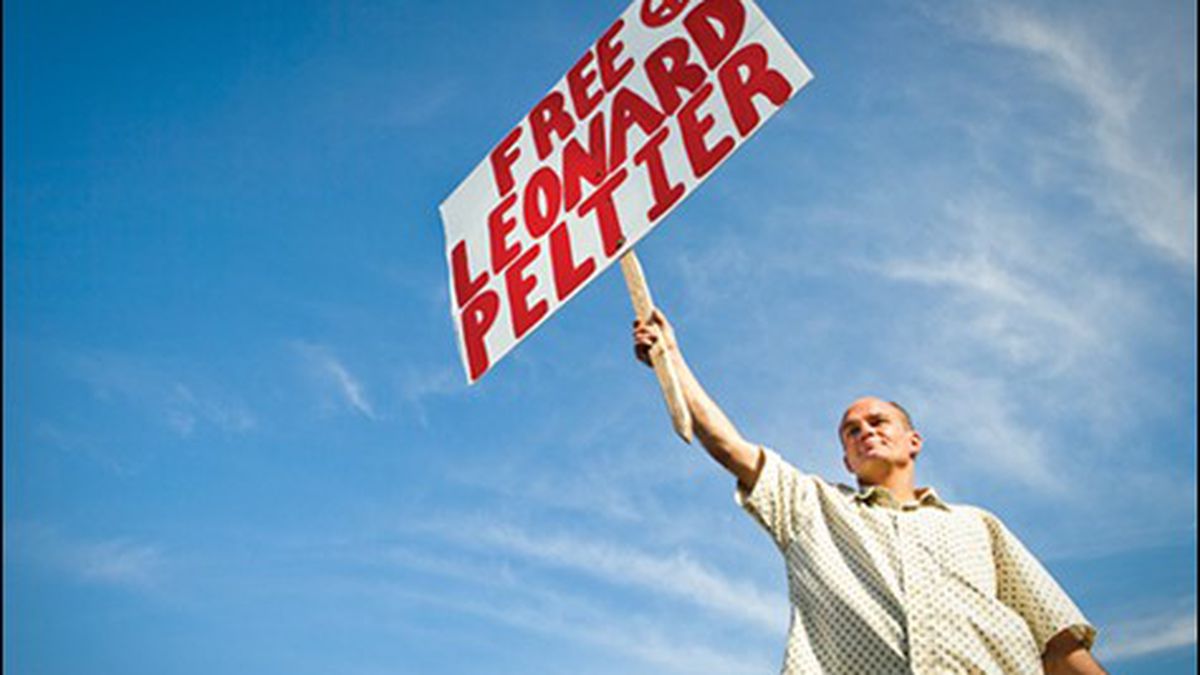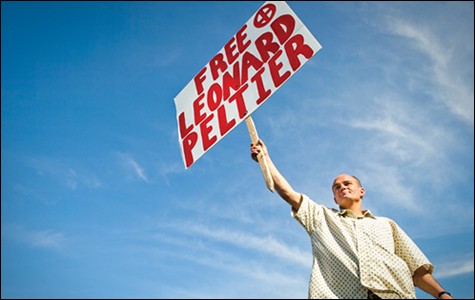Just past 5 p.m. on a windy January day, Shane Gray rides onto the Central Avenue catwalk that stretches across Interstate 80. He leans his battered bicycle against the fencing, puts a red-tailed hawk feather in his mouth, and begins waving a bright-red placard that reads “Free Leonard” at evening commuters.
Some drivers honk their horns in support even though many don’t know that “Leonard” refers to imprisoned Indian activist Leonard Peltier, who was controversially sentenced to life in federal prison in 1977 for the shooting deaths of two FBI agents on the Pine Ridge Reservation in South Dakota.
“It’s good when they honk,” Gray says cheerfully as a chilly wind tosses his thinning blonde hair, “because then the people who don’t know who Leonard is will take notice…. They’ll ask, ‘Who’s this Leonard guy, anyway?'”
About twelve years ago, Gray’s “Free Leonard” signs with their distinctive red lettering began appearing on freeway fences, abandoned billboards, neighborhood lampposts, and high in treetops. The signs, sometimes augmented with images of a medicine wheel and arrow, have become such a regular feature on the landscape that they have achieved a quasi-iconic status for the hundreds of thousands of people who have seen them as they drive the area bounded by Oakland, Richmond, and the Carquinez Strait.
While Gray’s placards are instantly recognizable, Gray himself has remained little more than a hazy figure blurred by the gossamer of freeway safety fences. But in the past year, the Richmond resident has begun to gain recognition — and not all of it good. To some, Gray is a folk hero who risks arrest and personal injury to rail against the unsympathetic goliath of federal government. Supporters have even purchased his signs as folksy artwork. To others, Gray is a public nuisance who should be stopped from littering the landscape with his lost cause. He avoids posting the placards on private property, preferring fences, poles, and trees that are publicly owned and within view of freeways. Nonetheless, after years of friendly warnings, law enforcement has begun to take a hard line.
On a recent rainy afternoon, Gray sits at a table at the Catahoula Coffee Company in Richmond. At 42, he has an athletic build, and his face is tanned from working outdoors as a landscaper, laborer, and house painter. He wraps his calloused hands around a warm mug of coffee and his light-blue eyes brighten as he talks about his commitment to Peltier’s case. “I’m not doing this for myself,” Gray said. “I do it because Peltier’s incarceration is wrong. It’s unjust.”
Gray committed to Peltier’s cause in 1999 after he attended a powwow in Berkeley held in honor of the imprisoned activist. Gray was moved by the stories of poverty and violent oppression on the Pine Ridge Reservation in the 1970s. He was also deeply moved by the persistent questions surrounding the evidence used to convict Peltier as the sole person responsible for killing two FBI agents during a shootout that at least forty Native Americans participated in, according to FBI documents.
The day after the powwow, Gray made his first placard from a discarded cardboard box and paint leftover at a job site. Now, twelve years later, he has painted and posted thousands of signs and says he continues to make each new sign with the same enthusiasm and determination as he did his first. The campaign has become the central theme of his life and he says he’s not quite sure what he’d do without it. “I don’t know why I got involved in the Leonard Peltier case,” Gray said. “I have never been involved in any other activism before or since.”
Occasionally, Gray borrows tree-climbing gear from a friend to post the signs high in treetops. They can be hard to see, but have a bigger impact once noticed. “People are surprised to see the signs sixty feet up a eucalyptus tree and that really gets their attention,” Gray said.
His biggest coup, he says, was an abandoned billboard just off of Interstate 580 in Richmond. He painted the billboard white, and in his unique cursive painted “Free Leonard” in four-foot-high letters. Taggers would regularly spray paint over his message with their own. For months, Gray returned several times a week to re-paint until Caltrans finally tore the billboard down.
Gray also brings his placards to the scene of major media events in the hopes of getting his message serendipitously picked up by television cameras. He avoids events where there has been tragedy such as the loss of life or injury, but when a massive sinkhole opened up in Richmond last April, swallowing two cars and attracting a fleet of television news vans, Gray was in the background quietly holding one of his placards. During the 2010 World Series, Gray was a regular feature outside AT&T Park, even paddling a kayak covered with “Free Leonard” signs into the home-run waters of McCovey Cove just over the right-field wall.
Hollywood and recording artists made Peltier’s case widely known through the 1980s and 1990s. His cause reached the apex of its popularity in 1992 with the release of the Robert Redford-produced documentary Incident at Oglala and the Michael Apted movie Thunderheart, which is based on the Pine Ridge shootout and stars Val Kilmer and Sam Shepard. Musicians such as U2, Buffy Sainte-Marie, Robbie Robertson, and Rage Against the Machine have recorded songs calling for Peltier’s release. His case became an international controversy in the early-1990s when the Italian, Belgian, and European parliaments approved resolutions in support of a Peltier pardon.
But Peltier’s cause began to lose momentum in 2000. Attorneys had exhausted all of his appeals, and despite expectations, President Bill Clinton refused to give Peltier a presidential pardon as he left office. Hollywood stopped making films and Peltier’s name slowly began to disappear from the headlines. Peltier is now 66 and in declining health. In 2009, a parole commission turned him down in his first hearing in fifteen years, and hope that he might win his freedom diminishes with each passing year.
Gray is not politically savvy nor does he understand the intricacies of the United States Court of Appeals. But the disappointing nuances of Peltier’s quest for parole have not lessened Gray’s commitment. His signs have served as much needed motivation for Bay Area activists. Aaron “A-Ron” Mirmalek, who produced the 2010 Free Leonard Peltier album, a compilation of hip-hop tracks calling attention to Peltier’s case, says Gray is an inspiration. “Shane was at the album release party and I gave him special recognition because he has worked so hard and his commitment over the years has had a huge positive effect,” said Mirmalek, who is related to Peltier. “Seeing him on the freeways waving his signs always inspires me.”
Supporters regularly offer Gray contributions for paint and other materials. Besides accepting one $20 donation from an acquaintance, he says he has always refused to accept money. But in the past year, there has been some interest in his signs as artwork. Richmond resident Scott Guitteau bought a “Free Leonard” placard for its artistic value. “It’s like street-art-meets-folk-art,” Guitteau said. “It’s more simple as opposed to the urban street work of well-known artists like Banksy or Shepard Fairey. Gray’s signs are rural, innocent.”
But not everyone thinks so. In years past, Gray was on friendly terms with sheriff’s deputies, local police, and CHP officers, many who know him by name. For years they had given him gentle warnings about posting signs in certain areas or waving placards when traffic is particularly heavy. Gray says he has always complied and there was never a serious problem. Typically, he uses any contact with the authorities to promote his cause. “Anytime the police stop me, I ask, ‘Are you familiar with the most prominent political prisoner in the United States fraudulently convicted by the FBI?'” Gray said rotely. “And when they say, ‘no,’ I say, ‘Well, that’s the reason he’s still in prison.'”
But lately, the authorities have not been so friendly. Last summer, the California Highway Patrol arrested Gray near an Interstate 80 onramp, and the evening before Thanksgiving, two Contra Costa County sheriff’s deputies showed up at his Richmond apartment and booked him into the county jail in Martinez. He was released with no charges at 1 a.m. though he was twenty miles from his home with no transportation and buses had long stopped running. Contra Costa County Sheriff’s spokesman Jimmy Lee says Gray was arrested because of a citizen complaint, and if he doesn’t stop putting up placards, he will eventually face charges.
The arrests have given Gray some pause. Since Thanksgiving he has thought more about retiring, though discussing the idea visibly unsettles him. He gets quiet and looks out the cafe window for a long time. “Or I could expand my territory …. I bet the signs would get a good response in Marin. People there know about Leonard,” he said, his eyes brightening. “What I really want to do is find the perfect location for a really big sign. It will be really high … higher than I’ve ever put anything before.”














